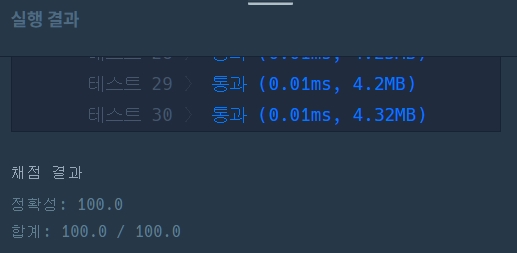Programmers 67257
수식 최대화
CODE ⌨️
#include <string>
#include <vector>
#include <deque>
#include <cmath>
using namespace std;
typedef long long ll;
bool op[3];
int cnt = 0;
deque<ll> DQ;
bool visited[3];
vector<ll> opvec;
ll answer = 0;
void solve(int depth)
{
if (depth == cnt)
{
deque<ll> DQ_temp = DQ;
for (int i = 0; i < cnt; i++)
{
int idx = 1;
while (idx < DQ_temp.size())
{
if (DQ_temp[idx] == opvec[i])
{
if (opvec[i] == 0)
{
DQ_temp[idx - 1] += DQ_temp[idx + 1];
DQ_temp.erase(DQ_temp.begin() + idx, DQ_temp.begin() + idx + 2);
}
else if (opvec[i] == 1)
{
DQ_temp[idx - 1] -= DQ_temp[idx + 1];
DQ_temp.erase(DQ_temp.begin() + idx, DQ_temp.begin() + idx + 2);
}
else if (opvec[i] == 2)
{
DQ_temp[idx - 1] *= DQ_temp[idx + 1];
DQ_temp.erase(DQ_temp.begin() + idx, DQ_temp.begin() + idx + 2);
}
}
else idx += 2;
}
}
answer = max(answer, abs(DQ_temp[0]));
return;
}
for (int i = 0; i < 3; i++)
{
if (!op[i]) continue;
if (visited[i]) continue;
visited[i] = true;
opvec.push_back(i);
solve(depth + 1);
opvec.pop_back();
visited[i] = false;
}
}
void func(ll idx, string s)
{
op[idx] = true;
DQ.push_back(stoll(s));
DQ.push_back(idx);
}
ll solution(string expression)
{
int idx = 0;
string str = "";
while (idx < expression.length())
{
if (expression[idx] == '+') func(0, str);
else if (expression[idx] == '-') func(1, str);
else if (expression[idx] == '*') func(2, str);
else
{
str += expression[idx++];
continue;
}
str = "";
idx++;
}
DQ.push_back(stoll(str));
for (int i = 0; i < 3; i++)
{
if (op[i]) cnt++;
}
solve(0);
return answer;
}
RESULT 💛

SIMPLE DISCUSSION ✏️
문자열 관련 문제였다. Deque의 활용법(DQ.erase(~))을 조금 더 공부할 수 있었다.
SOURCE 💎
Programmers_Link 👈 Click here
*****
NOT A TALENT ❎ NOT GIVING UP ✅
CopyRight ⓒ 2022 DCherish All Rights Reserved.
CopyRight ⓒ 2022 DCherish All Rights Reserved.